Taxation Analysis: Residency, Tax Calculation, and Fringe Benefits
VerifiedAdded on 2020/04/29
|12
|2612
|87
Homework Assignment
AI Summary
This taxation assignment addresses two main questions. The first question focuses on determining Daniel's residency status for the 2016/2017 tax year based on domicile, 183-day, and superannuation tests, subsequently calculating his tax payable using his income details, including salary, superannuation, interest, rental income, bonuses, and dividends. The second question analyzes various transactions involving Joyce, a marketing manager, to determine fringe benefit tax (FBT) or income tax implications. The analysis covers salary, superannuation, school fees, travel costs, professional memberships, car benefits, gym memberships, and loan and debt waiver benefits, calculating the FBT liability for the year, with detailed working notes on car fringe benefits, loan fringe benefits, debt waivers, and travel and professional membership expenses. The assignment highlights the difference between income tax and FBT obligations, providing a comprehensive overview of Australian taxation principles.
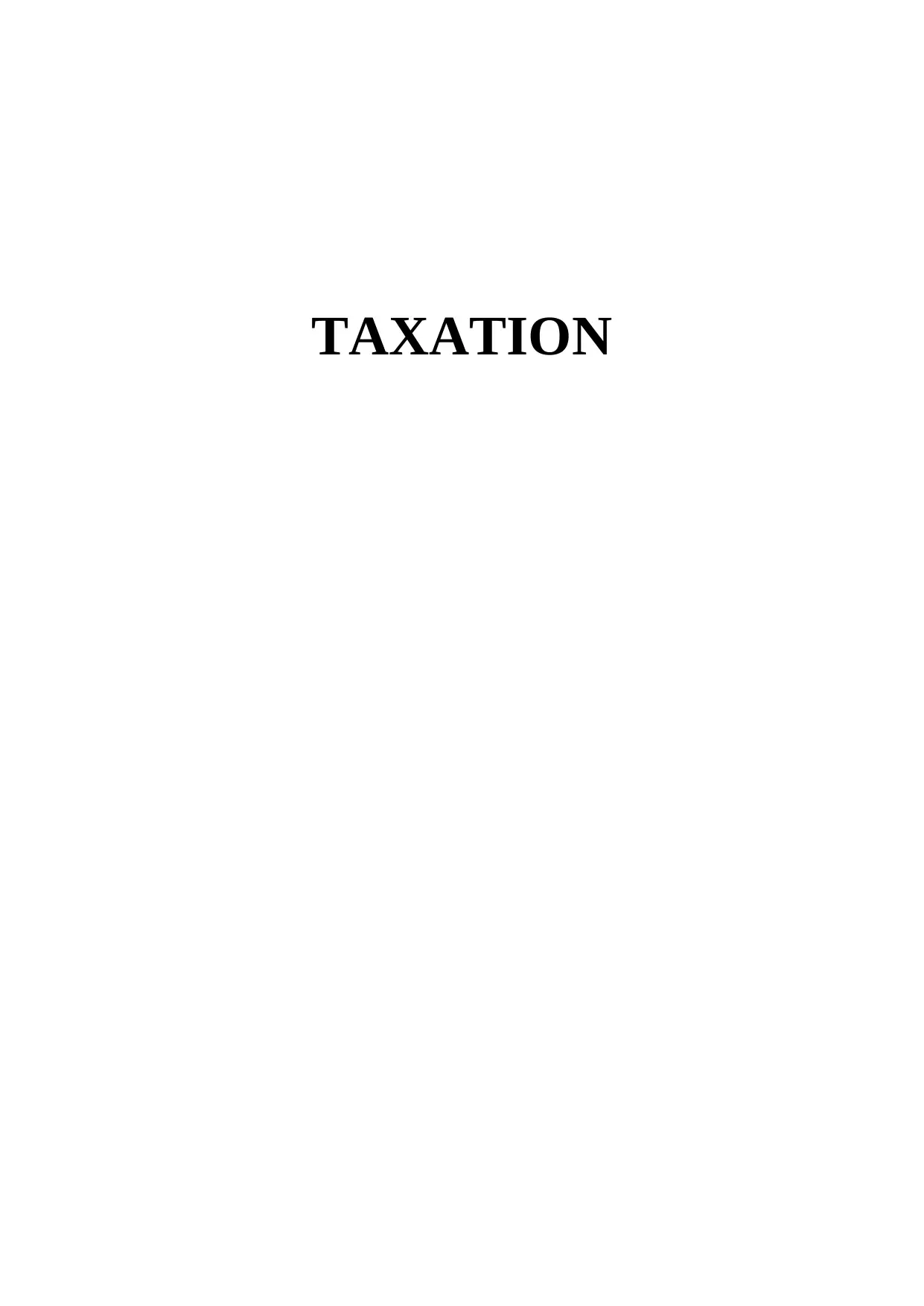
TAXATION
Paraphrase This Document
Need a fresh take? Get an instant paraphrase of this document with our AI Paraphraser
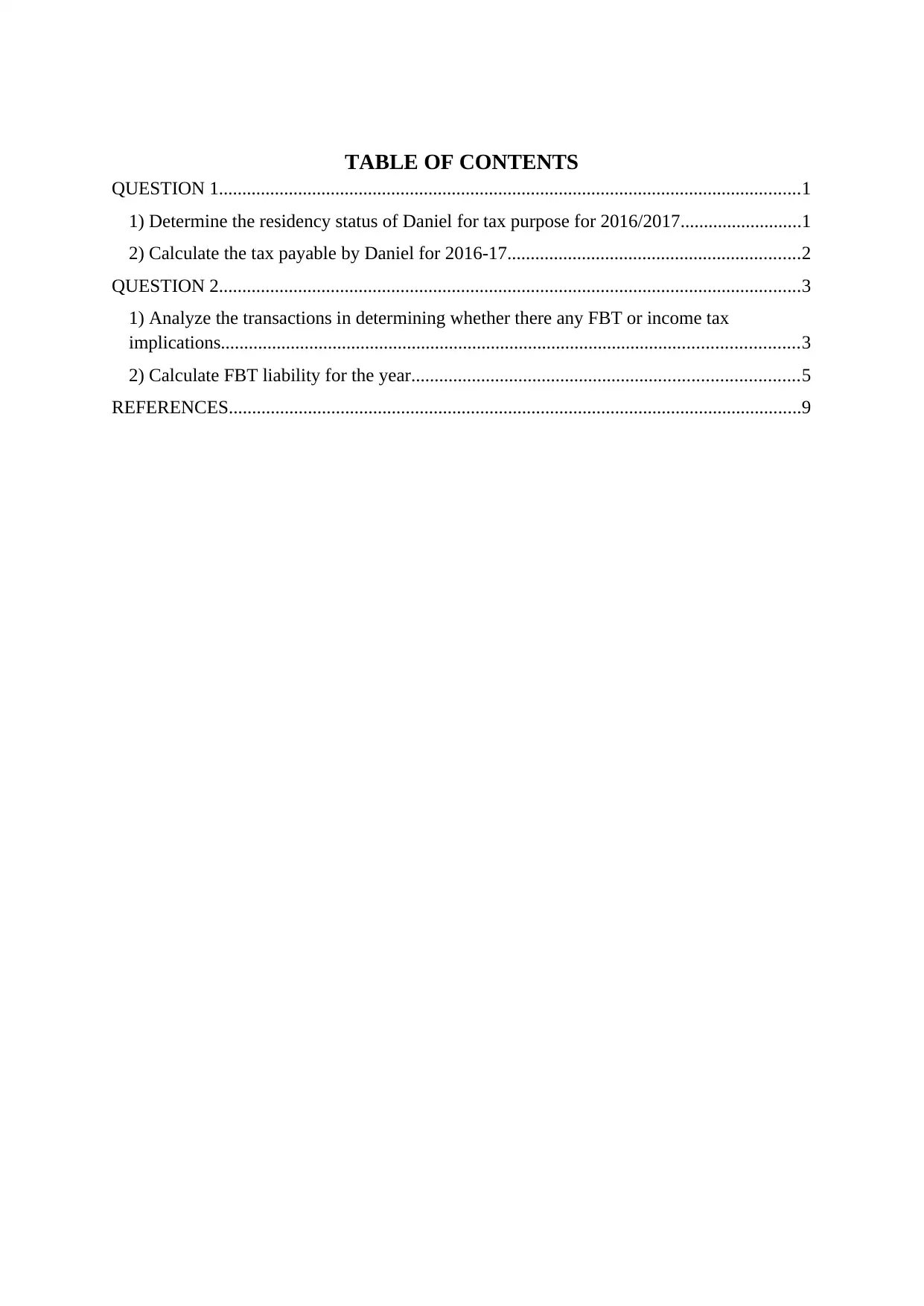
TABLE OF CONTENTS
QUESTION 1.............................................................................................................................1
1) Determine the residency status of Daniel for tax purpose for 2016/2017..........................1
2) Calculate the tax payable by Daniel for 2016-17...............................................................2
QUESTION 2.............................................................................................................................3
1) Analyze the transactions in determining whether there any FBT or income tax
implications............................................................................................................................3
2) Calculate FBT liability for the year...................................................................................5
REFERENCES...........................................................................................................................9
QUESTION 1.............................................................................................................................1
1) Determine the residency status of Daniel for tax purpose for 2016/2017..........................1
2) Calculate the tax payable by Daniel for 2016-17...............................................................2
QUESTION 2.............................................................................................................................3
1) Analyze the transactions in determining whether there any FBT or income tax
implications............................................................................................................................3
2) Calculate FBT liability for the year...................................................................................5
REFERENCES...........................................................................................................................9
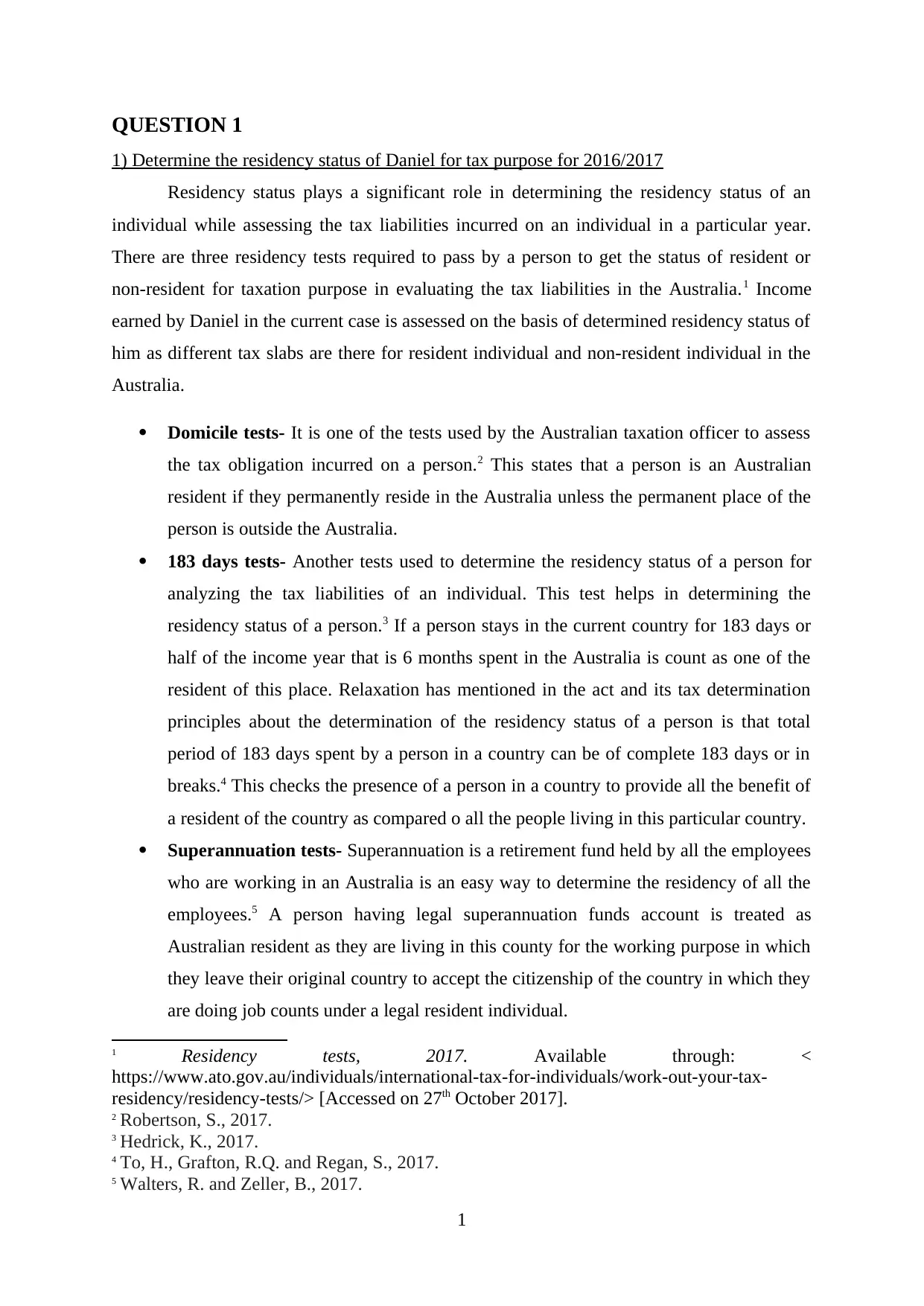
QUESTION 1
1) Determine the residency status of Daniel for tax purpose for 2016/2017
Residency status plays a significant role in determining the residency status of an
individual while assessing the tax liabilities incurred on an individual in a particular year.
There are three residency tests required to pass by a person to get the status of resident or
non-resident for taxation purpose in evaluating the tax liabilities in the Australia.1 Income
earned by Daniel in the current case is assessed on the basis of determined residency status of
him as different tax slabs are there for resident individual and non-resident individual in the
Australia.
Domicile tests- It is one of the tests used by the Australian taxation officer to assess
the tax obligation incurred on a person.2 This states that a person is an Australian
resident if they permanently reside in the Australia unless the permanent place of the
person is outside the Australia.
183 days tests- Another tests used to determine the residency status of a person for
analyzing the tax liabilities of an individual. This test helps in determining the
residency status of a person.3 If a person stays in the current country for 183 days or
half of the income year that is 6 months spent in the Australia is count as one of the
resident of this place. Relaxation has mentioned in the act and its tax determination
principles about the determination of the residency status of a person is that total
period of 183 days spent by a person in a country can be of complete 183 days or in
breaks.4 This checks the presence of a person in a country to provide all the benefit of
a resident of the country as compared o all the people living in this particular country.
Superannuation tests- Superannuation is a retirement fund held by all the employees
who are working in an Australia is an easy way to determine the residency of all the
employees.5 A person having legal superannuation funds account is treated as
Australian resident as they are living in this county for the working purpose in which
they leave their original country to accept the citizenship of the country in which they
are doing job counts under a legal resident individual.
1 Residency tests, 2017. Available through: <
https://www.ato.gov.au/individuals/international-tax-for-individuals/work-out-your-tax-
residency/residency-tests/> [Accessed on 27th October 2017].
2 Robertson, S., 2017.
3 Hedrick, K., 2017.
4 To, H., Grafton, R.Q. and Regan, S., 2017.
5 Walters, R. and Zeller, B., 2017.
1
1) Determine the residency status of Daniel for tax purpose for 2016/2017
Residency status plays a significant role in determining the residency status of an
individual while assessing the tax liabilities incurred on an individual in a particular year.
There are three residency tests required to pass by a person to get the status of resident or
non-resident for taxation purpose in evaluating the tax liabilities in the Australia.1 Income
earned by Daniel in the current case is assessed on the basis of determined residency status of
him as different tax slabs are there for resident individual and non-resident individual in the
Australia.
Domicile tests- It is one of the tests used by the Australian taxation officer to assess
the tax obligation incurred on a person.2 This states that a person is an Australian
resident if they permanently reside in the Australia unless the permanent place of the
person is outside the Australia.
183 days tests- Another tests used to determine the residency status of a person for
analyzing the tax liabilities of an individual. This test helps in determining the
residency status of a person.3 If a person stays in the current country for 183 days or
half of the income year that is 6 months spent in the Australia is count as one of the
resident of this place. Relaxation has mentioned in the act and its tax determination
principles about the determination of the residency status of a person is that total
period of 183 days spent by a person in a country can be of complete 183 days or in
breaks.4 This checks the presence of a person in a country to provide all the benefit of
a resident of the country as compared o all the people living in this particular country.
Superannuation tests- Superannuation is a retirement fund held by all the employees
who are working in an Australia is an easy way to determine the residency of all the
employees.5 A person having legal superannuation funds account is treated as
Australian resident as they are living in this county for the working purpose in which
they leave their original country to accept the citizenship of the country in which they
are doing job counts under a legal resident individual.
1 Residency tests, 2017. Available through: <
https://www.ato.gov.au/individuals/international-tax-for-individuals/work-out-your-tax-
residency/residency-tests/> [Accessed on 27th October 2017].
2 Robertson, S., 2017.
3 Hedrick, K., 2017.
4 To, H., Grafton, R.Q. and Regan, S., 2017.
5 Walters, R. and Zeller, B., 2017.
1
⊘ This is a preview!⊘
Do you want full access?
Subscribe today to unlock all pages.

Trusted by 1+ million students worldwide
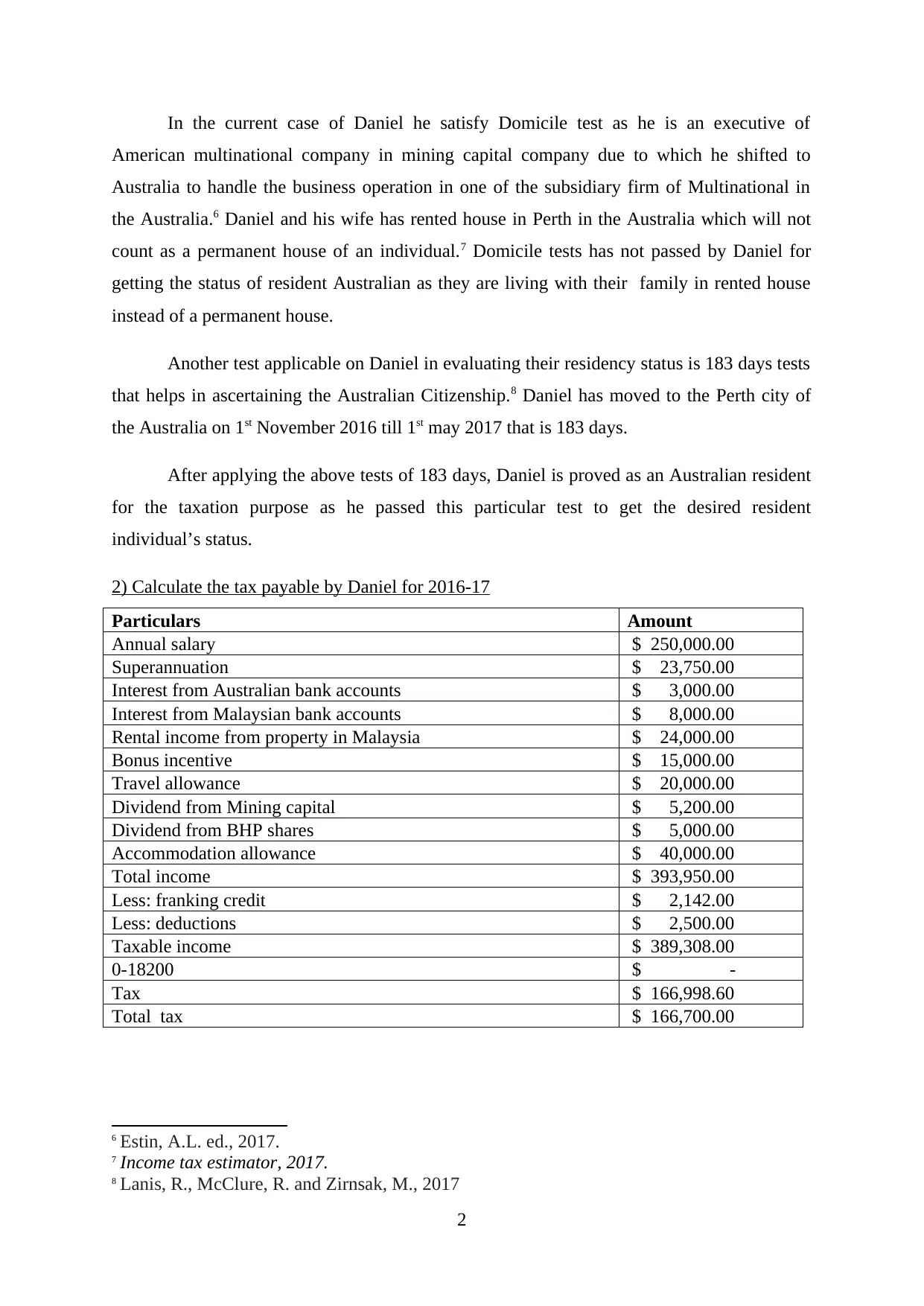
In the current case of Daniel he satisfy Domicile test as he is an executive of
American multinational company in mining capital company due to which he shifted to
Australia to handle the business operation in one of the subsidiary firm of Multinational in
the Australia.6 Daniel and his wife has rented house in Perth in the Australia which will not
count as a permanent house of an individual.7 Domicile tests has not passed by Daniel for
getting the status of resident Australian as they are living with their family in rented house
instead of a permanent house.
Another test applicable on Daniel in evaluating their residency status is 183 days tests
that helps in ascertaining the Australian Citizenship.8 Daniel has moved to the Perth city of
the Australia on 1st November 2016 till 1st may 2017 that is 183 days.
After applying the above tests of 183 days, Daniel is proved as an Australian resident
for the taxation purpose as he passed this particular test to get the desired resident
individual’s status.
2) Calculate the tax payable by Daniel for 2016-17
Particulars Amount
Annual salary $ 250,000.00
Superannuation $ 23,750.00
Interest from Australian bank accounts $ 3,000.00
Interest from Malaysian bank accounts $ 8,000.00
Rental income from property in Malaysia $ 24,000.00
Bonus incentive $ 15,000.00
Travel allowance $ 20,000.00
Dividend from Mining capital $ 5,200.00
Dividend from BHP shares $ 5,000.00
Accommodation allowance $ 40,000.00
Total income $ 393,950.00
Less: franking credit $ 2,142.00
Less: deductions $ 2,500.00
Taxable income $ 389,308.00
0-18200 $ -
Tax $ 166,998.60
Total tax $ 166,700.00
6 Estin, A.L. ed., 2017.
7 Income tax estimator, 2017.
8 Lanis, R., McClure, R. and Zirnsak, M., 2017
2
American multinational company in mining capital company due to which he shifted to
Australia to handle the business operation in one of the subsidiary firm of Multinational in
the Australia.6 Daniel and his wife has rented house in Perth in the Australia which will not
count as a permanent house of an individual.7 Domicile tests has not passed by Daniel for
getting the status of resident Australian as they are living with their family in rented house
instead of a permanent house.
Another test applicable on Daniel in evaluating their residency status is 183 days tests
that helps in ascertaining the Australian Citizenship.8 Daniel has moved to the Perth city of
the Australia on 1st November 2016 till 1st may 2017 that is 183 days.
After applying the above tests of 183 days, Daniel is proved as an Australian resident
for the taxation purpose as he passed this particular test to get the desired resident
individual’s status.
2) Calculate the tax payable by Daniel for 2016-17
Particulars Amount
Annual salary $ 250,000.00
Superannuation $ 23,750.00
Interest from Australian bank accounts $ 3,000.00
Interest from Malaysian bank accounts $ 8,000.00
Rental income from property in Malaysia $ 24,000.00
Bonus incentive $ 15,000.00
Travel allowance $ 20,000.00
Dividend from Mining capital $ 5,200.00
Dividend from BHP shares $ 5,000.00
Accommodation allowance $ 40,000.00
Total income $ 393,950.00
Less: franking credit $ 2,142.00
Less: deductions $ 2,500.00
Taxable income $ 389,308.00
0-18200 $ -
Tax $ 166,998.60
Total tax $ 166,700.00
6 Estin, A.L. ed., 2017.
7 Income tax estimator, 2017.
8 Lanis, R., McClure, R. and Zirnsak, M., 2017
2
Paraphrase This Document
Need a fresh take? Get an instant paraphrase of this document with our AI Paraphraser
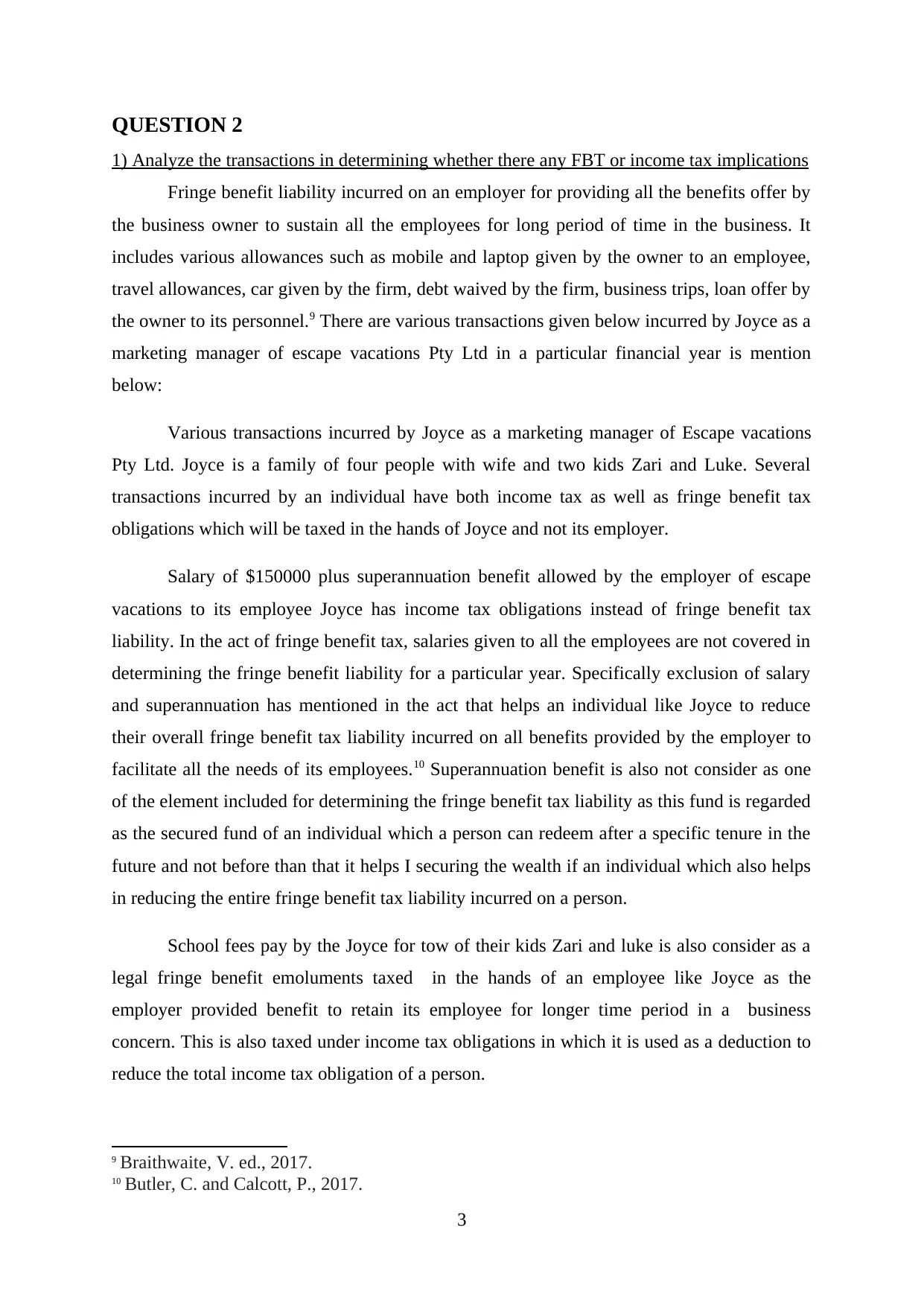
QUESTION 2
1) Analyze the transactions in determining whether there any FBT or income tax implications
Fringe benefit liability incurred on an employer for providing all the benefits offer by
the business owner to sustain all the employees for long period of time in the business. It
includes various allowances such as mobile and laptop given by the owner to an employee,
travel allowances, car given by the firm, debt waived by the firm, business trips, loan offer by
the owner to its personnel.9 There are various transactions given below incurred by Joyce as a
marketing manager of escape vacations Pty Ltd in a particular financial year is mention
below:
Various transactions incurred by Joyce as a marketing manager of Escape vacations
Pty Ltd. Joyce is a family of four people with wife and two kids Zari and Luke. Several
transactions incurred by an individual have both income tax as well as fringe benefit tax
obligations which will be taxed in the hands of Joyce and not its employer.
Salary of $150000 plus superannuation benefit allowed by the employer of escape
vacations to its employee Joyce has income tax obligations instead of fringe benefit tax
liability. In the act of fringe benefit tax, salaries given to all the employees are not covered in
determining the fringe benefit liability for a particular year. Specifically exclusion of salary
and superannuation has mentioned in the act that helps an individual like Joyce to reduce
their overall fringe benefit tax liability incurred on all benefits provided by the employer to
facilitate all the needs of its employees.10 Superannuation benefit is also not consider as one
of the element included for determining the fringe benefit tax liability as this fund is regarded
as the secured fund of an individual which a person can redeem after a specific tenure in the
future and not before than that it helps I securing the wealth if an individual which also helps
in reducing the entire fringe benefit tax liability incurred on a person.
School fees pay by the Joyce for tow of their kids Zari and luke is also consider as a
legal fringe benefit emoluments taxed in the hands of an employee like Joyce as the
employer provided benefit to retain its employee for longer time period in a business
concern. This is also taxed under income tax obligations in which it is used as a deduction to
reduce the total income tax obligation of a person.
9 Braithwaite, V. ed., 2017.
10 Butler, C. and Calcott, P., 2017.
3
1) Analyze the transactions in determining whether there any FBT or income tax implications
Fringe benefit liability incurred on an employer for providing all the benefits offer by
the business owner to sustain all the employees for long period of time in the business. It
includes various allowances such as mobile and laptop given by the owner to an employee,
travel allowances, car given by the firm, debt waived by the firm, business trips, loan offer by
the owner to its personnel.9 There are various transactions given below incurred by Joyce as a
marketing manager of escape vacations Pty Ltd in a particular financial year is mention
below:
Various transactions incurred by Joyce as a marketing manager of Escape vacations
Pty Ltd. Joyce is a family of four people with wife and two kids Zari and Luke. Several
transactions incurred by an individual have both income tax as well as fringe benefit tax
obligations which will be taxed in the hands of Joyce and not its employer.
Salary of $150000 plus superannuation benefit allowed by the employer of escape
vacations to its employee Joyce has income tax obligations instead of fringe benefit tax
liability. In the act of fringe benefit tax, salaries given to all the employees are not covered in
determining the fringe benefit liability for a particular year. Specifically exclusion of salary
and superannuation has mentioned in the act that helps an individual like Joyce to reduce
their overall fringe benefit tax liability incurred on all benefits provided by the employer to
facilitate all the needs of its employees.10 Superannuation benefit is also not consider as one
of the element included for determining the fringe benefit tax liability as this fund is regarded
as the secured fund of an individual which a person can redeem after a specific tenure in the
future and not before than that it helps I securing the wealth if an individual which also helps
in reducing the entire fringe benefit tax liability incurred on a person.
School fees pay by the Joyce for tow of their kids Zari and luke is also consider as a
legal fringe benefit emoluments taxed in the hands of an employee like Joyce as the
employer provided benefit to retain its employee for longer time period in a business
concern. This is also taxed under income tax obligations in which it is used as a deduction to
reduce the total income tax obligation of a person.
9 Braithwaite, V. ed., 2017.
10 Butler, C. and Calcott, P., 2017.
3
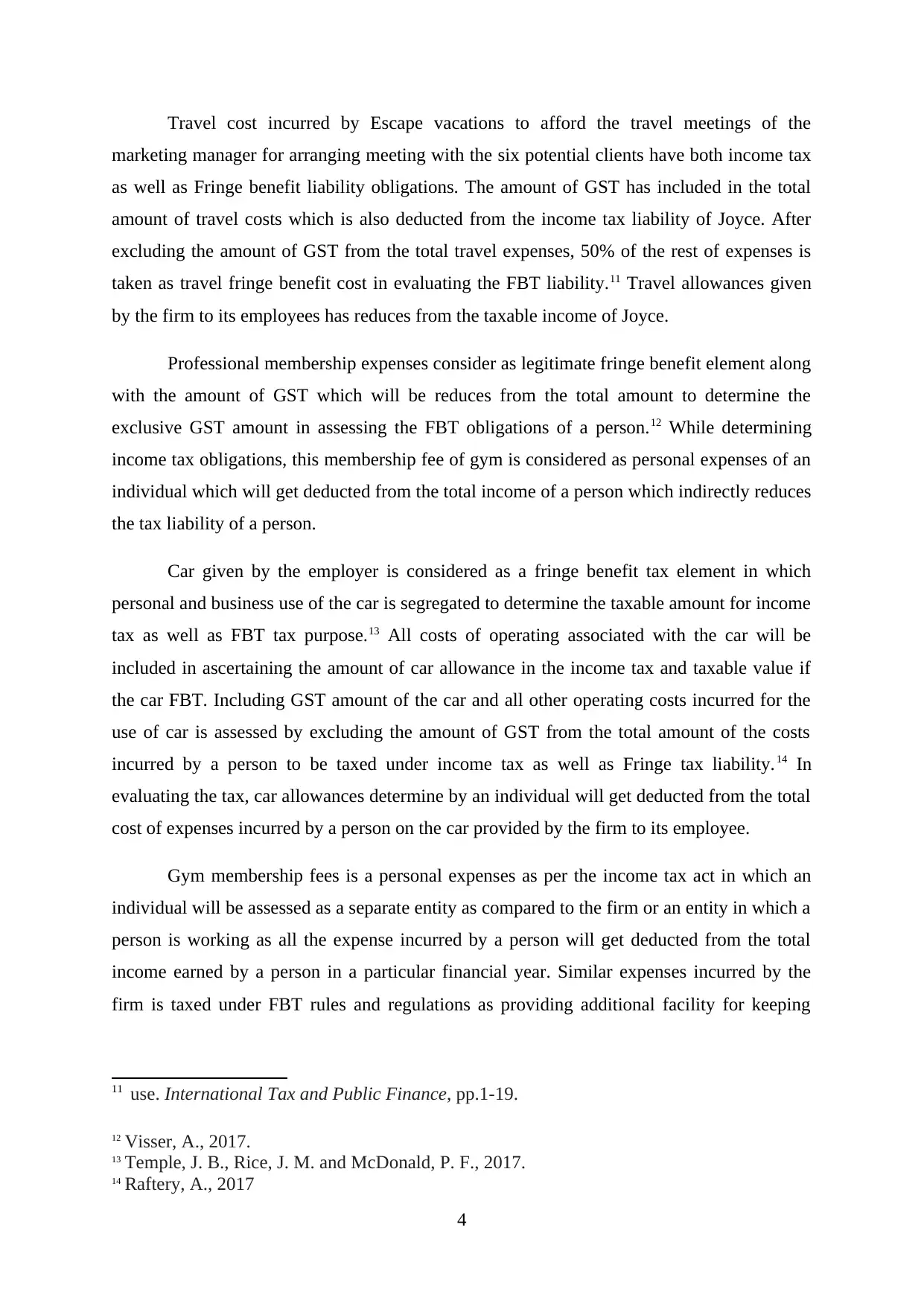
Travel cost incurred by Escape vacations to afford the travel meetings of the
marketing manager for arranging meeting with the six potential clients have both income tax
as well as Fringe benefit liability obligations. The amount of GST has included in the total
amount of travel costs which is also deducted from the income tax liability of Joyce. After
excluding the amount of GST from the total travel expenses, 50% of the rest of expenses is
taken as travel fringe benefit cost in evaluating the FBT liability.11 Travel allowances given
by the firm to its employees has reduces from the taxable income of Joyce.
Professional membership expenses consider as legitimate fringe benefit element along
with the amount of GST which will be reduces from the total amount to determine the
exclusive GST amount in assessing the FBT obligations of a person.12 While determining
income tax obligations, this membership fee of gym is considered as personal expenses of an
individual which will get deducted from the total income of a person which indirectly reduces
the tax liability of a person.
Car given by the employer is considered as a fringe benefit tax element in which
personal and business use of the car is segregated to determine the taxable amount for income
tax as well as FBT tax purpose.13 All costs of operating associated with the car will be
included in ascertaining the amount of car allowance in the income tax and taxable value if
the car FBT. Including GST amount of the car and all other operating costs incurred for the
use of car is assessed by excluding the amount of GST from the total amount of the costs
incurred by a person to be taxed under income tax as well as Fringe tax liability.14 In
evaluating the tax, car allowances determine by an individual will get deducted from the total
cost of expenses incurred by a person on the car provided by the firm to its employee.
Gym membership fees is a personal expenses as per the income tax act in which an
individual will be assessed as a separate entity as compared to the firm or an entity in which a
person is working as all the expense incurred by a person will get deducted from the total
income earned by a person in a particular financial year. Similar expenses incurred by the
firm is taxed under FBT rules and regulations as providing additional facility for keeping
11 use. International Tax and Public Finance, pp.1-19.
12 Visser, A., 2017.
13 Temple, J. B., Rice, J. M. and McDonald, P. F., 2017.
14 Raftery, A., 2017
4
marketing manager for arranging meeting with the six potential clients have both income tax
as well as Fringe benefit liability obligations. The amount of GST has included in the total
amount of travel costs which is also deducted from the income tax liability of Joyce. After
excluding the amount of GST from the total travel expenses, 50% of the rest of expenses is
taken as travel fringe benefit cost in evaluating the FBT liability.11 Travel allowances given
by the firm to its employees has reduces from the taxable income of Joyce.
Professional membership expenses consider as legitimate fringe benefit element along
with the amount of GST which will be reduces from the total amount to determine the
exclusive GST amount in assessing the FBT obligations of a person.12 While determining
income tax obligations, this membership fee of gym is considered as personal expenses of an
individual which will get deducted from the total income of a person which indirectly reduces
the tax liability of a person.
Car given by the employer is considered as a fringe benefit tax element in which
personal and business use of the car is segregated to determine the taxable amount for income
tax as well as FBT tax purpose.13 All costs of operating associated with the car will be
included in ascertaining the amount of car allowance in the income tax and taxable value if
the car FBT. Including GST amount of the car and all other operating costs incurred for the
use of car is assessed by excluding the amount of GST from the total amount of the costs
incurred by a person to be taxed under income tax as well as Fringe tax liability.14 In
evaluating the tax, car allowances determine by an individual will get deducted from the total
cost of expenses incurred by a person on the car provided by the firm to its employee.
Gym membership fees is a personal expenses as per the income tax act in which an
individual will be assessed as a separate entity as compared to the firm or an entity in which a
person is working as all the expense incurred by a person will get deducted from the total
income earned by a person in a particular financial year. Similar expenses incurred by the
firm is taxed under FBT rules and regulations as providing additional facility for keeping
11 use. International Tax and Public Finance, pp.1-19.
12 Visser, A., 2017.
13 Temple, J. B., Rice, J. M. and McDonald, P. F., 2017.
14 Raftery, A., 2017
4
⊘ This is a preview!⊘
Do you want full access?
Subscribe today to unlock all pages.

Trusted by 1+ million students worldwide
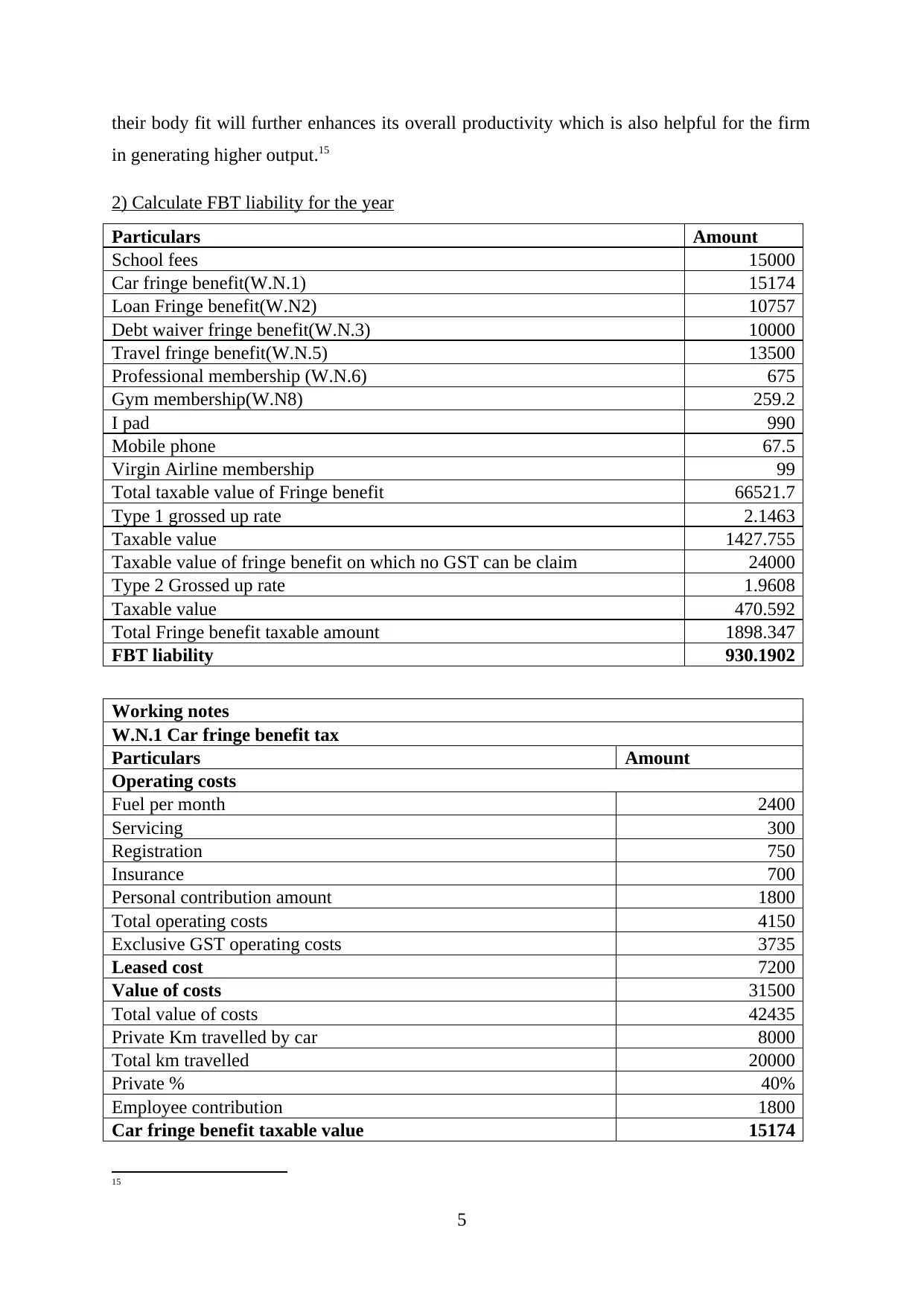
their body fit will further enhances its overall productivity which is also helpful for the firm
in generating higher output.15
2) Calculate FBT liability for the year
Particulars Amount
School fees 15000
Car fringe benefit(W.N.1) 15174
Loan Fringe benefit(W.N2) 10757
Debt waiver fringe benefit(W.N.3) 10000
Travel fringe benefit(W.N.5) 13500
Professional membership (W.N.6) 675
Gym membership(W.N8) 259.2
I pad 990
Mobile phone 67.5
Virgin Airline membership 99
Total taxable value of Fringe benefit 66521.7
Type 1 grossed up rate 2.1463
Taxable value 1427.755
Taxable value of fringe benefit on which no GST can be claim 24000
Type 2 Grossed up rate 1.9608
Taxable value 470.592
Total Fringe benefit taxable amount 1898.347
FBT liability 930.1902
Working notes
W.N.1 Car fringe benefit tax
Particulars Amount
Operating costs
Fuel per month 2400
Servicing 300
Registration 750
Insurance 700
Personal contribution amount 1800
Total operating costs 4150
Exclusive GST operating costs 3735
Leased cost 7200
Value of costs 31500
Total value of costs 42435
Private Km travelled by car 8000
Total km travelled 20000
Private % 40%
Employee contribution 1800
Car fringe benefit taxable value 15174
15
5
in generating higher output.15
2) Calculate FBT liability for the year
Particulars Amount
School fees 15000
Car fringe benefit(W.N.1) 15174
Loan Fringe benefit(W.N2) 10757
Debt waiver fringe benefit(W.N.3) 10000
Travel fringe benefit(W.N.5) 13500
Professional membership (W.N.6) 675
Gym membership(W.N8) 259.2
I pad 990
Mobile phone 67.5
Virgin Airline membership 99
Total taxable value of Fringe benefit 66521.7
Type 1 grossed up rate 2.1463
Taxable value 1427.755
Taxable value of fringe benefit on which no GST can be claim 24000
Type 2 Grossed up rate 1.9608
Taxable value 470.592
Total Fringe benefit taxable amount 1898.347
FBT liability 930.1902
Working notes
W.N.1 Car fringe benefit tax
Particulars Amount
Operating costs
Fuel per month 2400
Servicing 300
Registration 750
Insurance 700
Personal contribution amount 1800
Total operating costs 4150
Exclusive GST operating costs 3735
Leased cost 7200
Value of costs 31500
Total value of costs 42435
Private Km travelled by car 8000
Total km travelled 20000
Private % 40%
Employee contribution 1800
Car fringe benefit taxable value 15174
15
5
Paraphrase This Document
Need a fresh take? Get an instant paraphrase of this document with our AI Paraphraser
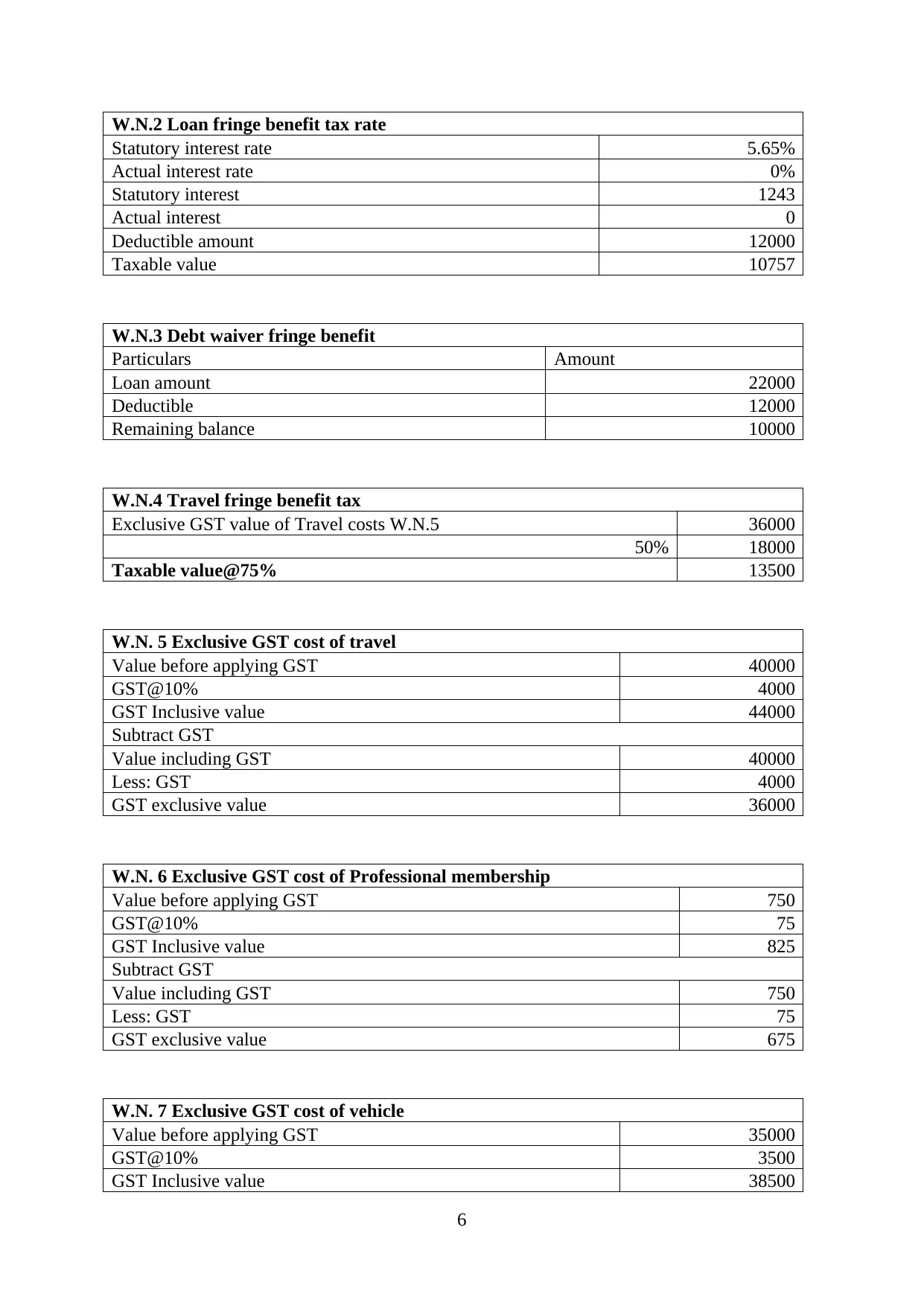
W.N.2 Loan fringe benefit tax rate
Statutory interest rate 5.65%
Actual interest rate 0%
Statutory interest 1243
Actual interest 0
Deductible amount 12000
Taxable value 10757
W.N.3 Debt waiver fringe benefit
Particulars Amount
Loan amount 22000
Deductible 12000
Remaining balance 10000
W.N.4 Travel fringe benefit tax
Exclusive GST value of Travel costs W.N.5 36000
50% 18000
Taxable value@75% 13500
W.N. 5 Exclusive GST cost of travel
Value before applying GST 40000
GST@10% 4000
GST Inclusive value 44000
Subtract GST
Value including GST 40000
Less: GST 4000
GST exclusive value 36000
W.N. 6 Exclusive GST cost of Professional membership
Value before applying GST 750
GST@10% 75
GST Inclusive value 825
Subtract GST
Value including GST 750
Less: GST 75
GST exclusive value 675
W.N. 7 Exclusive GST cost of vehicle
Value before applying GST 35000
GST@10% 3500
GST Inclusive value 38500
6
Statutory interest rate 5.65%
Actual interest rate 0%
Statutory interest 1243
Actual interest 0
Deductible amount 12000
Taxable value 10757
W.N.3 Debt waiver fringe benefit
Particulars Amount
Loan amount 22000
Deductible 12000
Remaining balance 10000
W.N.4 Travel fringe benefit tax
Exclusive GST value of Travel costs W.N.5 36000
50% 18000
Taxable value@75% 13500
W.N. 5 Exclusive GST cost of travel
Value before applying GST 40000
GST@10% 4000
GST Inclusive value 44000
Subtract GST
Value including GST 40000
Less: GST 4000
GST exclusive value 36000
W.N. 6 Exclusive GST cost of Professional membership
Value before applying GST 750
GST@10% 75
GST Inclusive value 825
Subtract GST
Value including GST 750
Less: GST 75
GST exclusive value 675
W.N. 7 Exclusive GST cost of vehicle
Value before applying GST 35000
GST@10% 3500
GST Inclusive value 38500
6
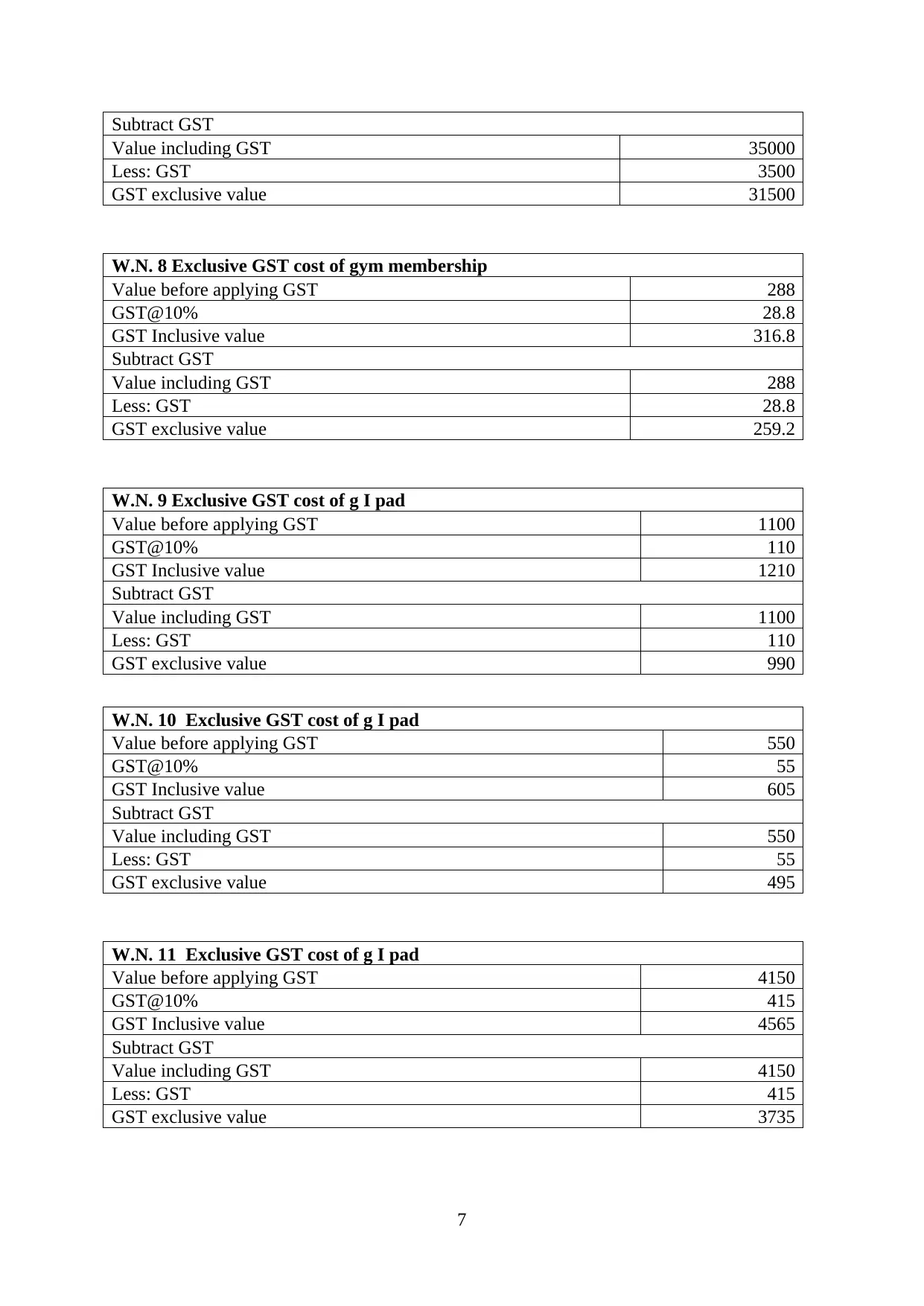
Subtract GST
Value including GST 35000
Less: GST 3500
GST exclusive value 31500
W.N. 8 Exclusive GST cost of gym membership
Value before applying GST 288
GST@10% 28.8
GST Inclusive value 316.8
Subtract GST
Value including GST 288
Less: GST 28.8
GST exclusive value 259.2
W.N. 9 Exclusive GST cost of g I pad
Value before applying GST 1100
GST@10% 110
GST Inclusive value 1210
Subtract GST
Value including GST 1100
Less: GST 110
GST exclusive value 990
W.N. 10 Exclusive GST cost of g I pad
Value before applying GST 550
GST@10% 55
GST Inclusive value 605
Subtract GST
Value including GST 550
Less: GST 55
GST exclusive value 495
W.N. 11 Exclusive GST cost of g I pad
Value before applying GST 4150
GST@10% 415
GST Inclusive value 4565
Subtract GST
Value including GST 4150
Less: GST 415
GST exclusive value 3735
7
Value including GST 35000
Less: GST 3500
GST exclusive value 31500
W.N. 8 Exclusive GST cost of gym membership
Value before applying GST 288
GST@10% 28.8
GST Inclusive value 316.8
Subtract GST
Value including GST 288
Less: GST 28.8
GST exclusive value 259.2
W.N. 9 Exclusive GST cost of g I pad
Value before applying GST 1100
GST@10% 110
GST Inclusive value 1210
Subtract GST
Value including GST 1100
Less: GST 110
GST exclusive value 990
W.N. 10 Exclusive GST cost of g I pad
Value before applying GST 550
GST@10% 55
GST Inclusive value 605
Subtract GST
Value including GST 550
Less: GST 55
GST exclusive value 495
W.N. 11 Exclusive GST cost of g I pad
Value before applying GST 4150
GST@10% 415
GST Inclusive value 4565
Subtract GST
Value including GST 4150
Less: GST 415
GST exclusive value 3735
7
⊘ This is a preview!⊘
Do you want full access?
Subscribe today to unlock all pages.

Trusted by 1+ million students worldwide
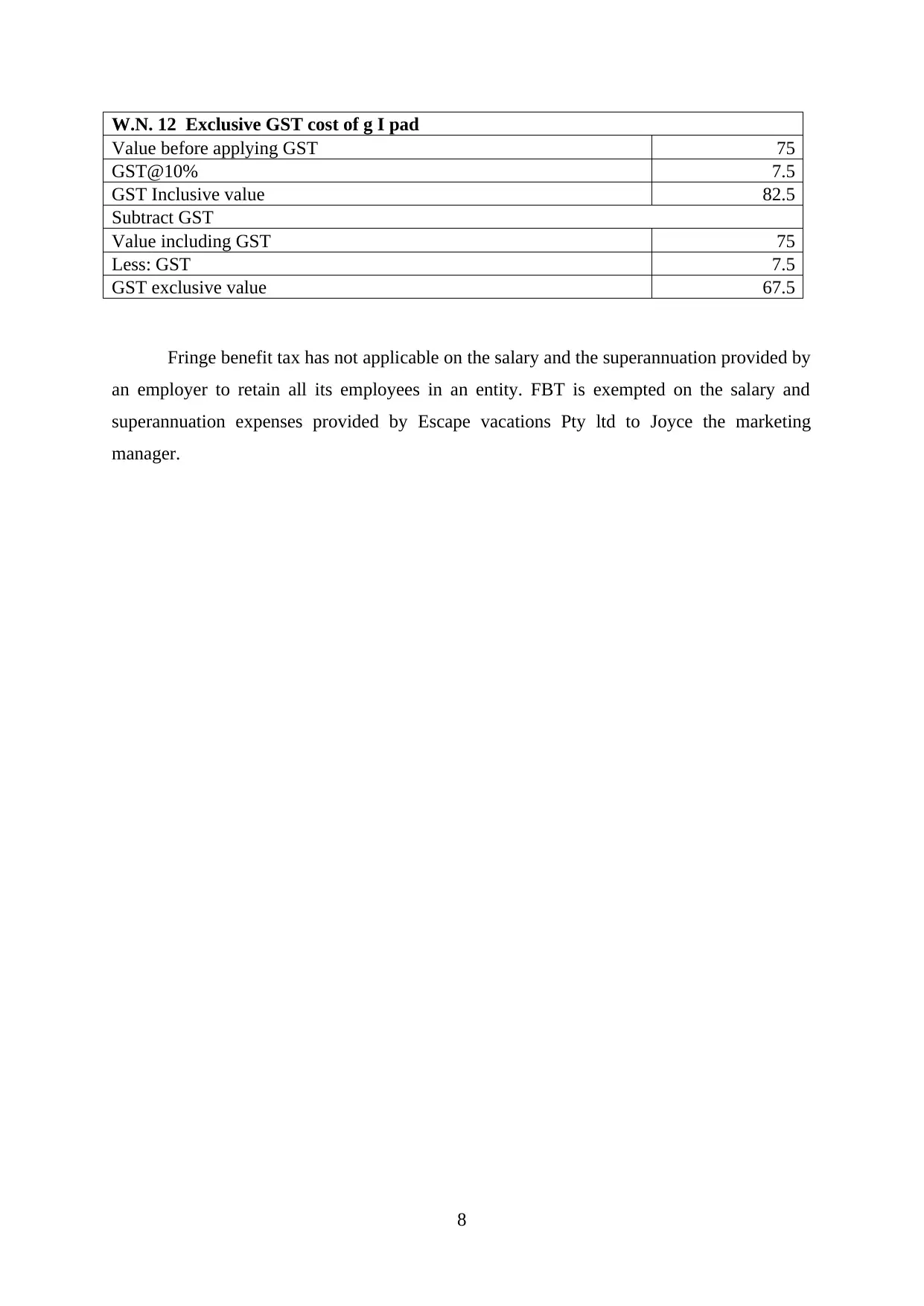
W.N. 12 Exclusive GST cost of g I pad
Value before applying GST 75
GST@10% 7.5
GST Inclusive value 82.5
Subtract GST
Value including GST 75
Less: GST 7.5
GST exclusive value 67.5
Fringe benefit tax has not applicable on the salary and the superannuation provided by
an employer to retain all its employees in an entity. FBT is exempted on the salary and
superannuation expenses provided by Escape vacations Pty ltd to Joyce the marketing
manager.
8
Value before applying GST 75
GST@10% 7.5
GST Inclusive value 82.5
Subtract GST
Value including GST 75
Less: GST 7.5
GST exclusive value 67.5
Fringe benefit tax has not applicable on the salary and the superannuation provided by
an employer to retain all its employees in an entity. FBT is exempted on the salary and
superannuation expenses provided by Escape vacations Pty ltd to Joyce the marketing
manager.
8
Paraphrase This Document
Need a fresh take? Get an instant paraphrase of this document with our AI Paraphraser
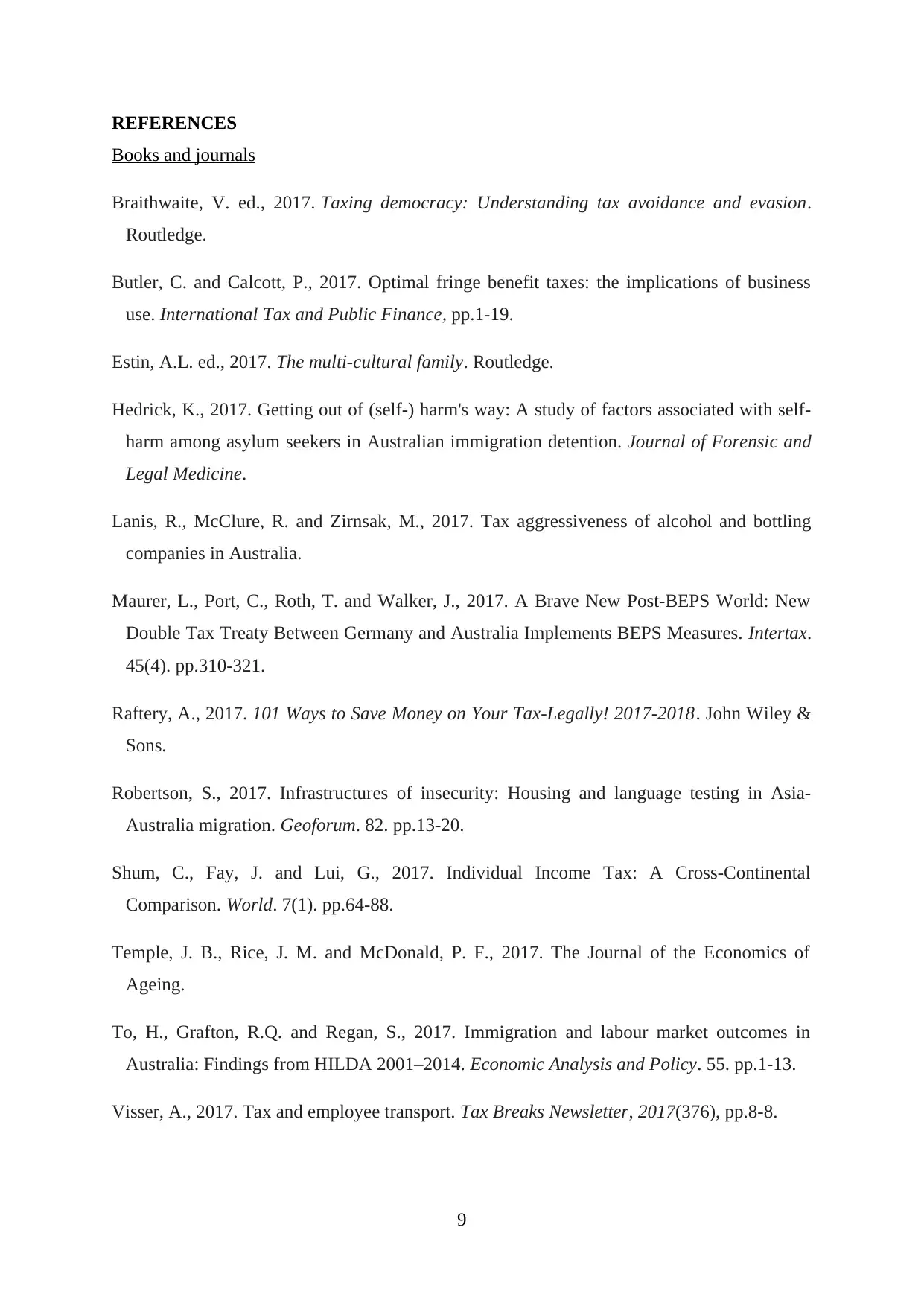
REFERENCES
Books and journals
Braithwaite, V. ed., 2017. Taxing democracy: Understanding tax avoidance and evasion.
Routledge.
Butler, C. and Calcott, P., 2017. Optimal fringe benefit taxes: the implications of business
use. International Tax and Public Finance, pp.1-19.
Estin, A.L. ed., 2017. The multi-cultural family. Routledge.
Hedrick, K., 2017. Getting out of (self-) harm's way: A study of factors associated with self-
harm among asylum seekers in Australian immigration detention. Journal of Forensic and
Legal Medicine.
Lanis, R., McClure, R. and Zirnsak, M., 2017. Tax aggressiveness of alcohol and bottling
companies in Australia.
Maurer, L., Port, C., Roth, T. and Walker, J., 2017. A Brave New Post-BEPS World: New
Double Tax Treaty Between Germany and Australia Implements BEPS Measures. Intertax.
45(4). pp.310-321.
Raftery, A., 2017. 101 Ways to Save Money on Your Tax-Legally! 2017-2018. John Wiley &
Sons.
Robertson, S., 2017. Infrastructures of insecurity: Housing and language testing in Asia-
Australia migration. Geoforum. 82. pp.13-20.
Shum, C., Fay, J. and Lui, G., 2017. Individual Income Tax: A Cross-Continental
Comparison. World. 7(1). pp.64-88.
Temple, J. B., Rice, J. M. and McDonald, P. F., 2017. The Journal of the Economics of
Ageing.
To, H., Grafton, R.Q. and Regan, S., 2017. Immigration and labour market outcomes in
Australia: Findings from HILDA 2001–2014. Economic Analysis and Policy. 55. pp.1-13.
Visser, A., 2017. Tax and employee transport. Tax Breaks Newsletter, 2017(376), pp.8-8.
9
Books and journals
Braithwaite, V. ed., 2017. Taxing democracy: Understanding tax avoidance and evasion.
Routledge.
Butler, C. and Calcott, P., 2017. Optimal fringe benefit taxes: the implications of business
use. International Tax and Public Finance, pp.1-19.
Estin, A.L. ed., 2017. The multi-cultural family. Routledge.
Hedrick, K., 2017. Getting out of (self-) harm's way: A study of factors associated with self-
harm among asylum seekers in Australian immigration detention. Journal of Forensic and
Legal Medicine.
Lanis, R., McClure, R. and Zirnsak, M., 2017. Tax aggressiveness of alcohol and bottling
companies in Australia.
Maurer, L., Port, C., Roth, T. and Walker, J., 2017. A Brave New Post-BEPS World: New
Double Tax Treaty Between Germany and Australia Implements BEPS Measures. Intertax.
45(4). pp.310-321.
Raftery, A., 2017. 101 Ways to Save Money on Your Tax-Legally! 2017-2018. John Wiley &
Sons.
Robertson, S., 2017. Infrastructures of insecurity: Housing and language testing in Asia-
Australia migration. Geoforum. 82. pp.13-20.
Shum, C., Fay, J. and Lui, G., 2017. Individual Income Tax: A Cross-Continental
Comparison. World. 7(1). pp.64-88.
Temple, J. B., Rice, J. M. and McDonald, P. F., 2017. The Journal of the Economics of
Ageing.
To, H., Grafton, R.Q. and Regan, S., 2017. Immigration and labour market outcomes in
Australia: Findings from HILDA 2001–2014. Economic Analysis and Policy. 55. pp.1-13.
Visser, A., 2017. Tax and employee transport. Tax Breaks Newsletter, 2017(376), pp.8-8.
9
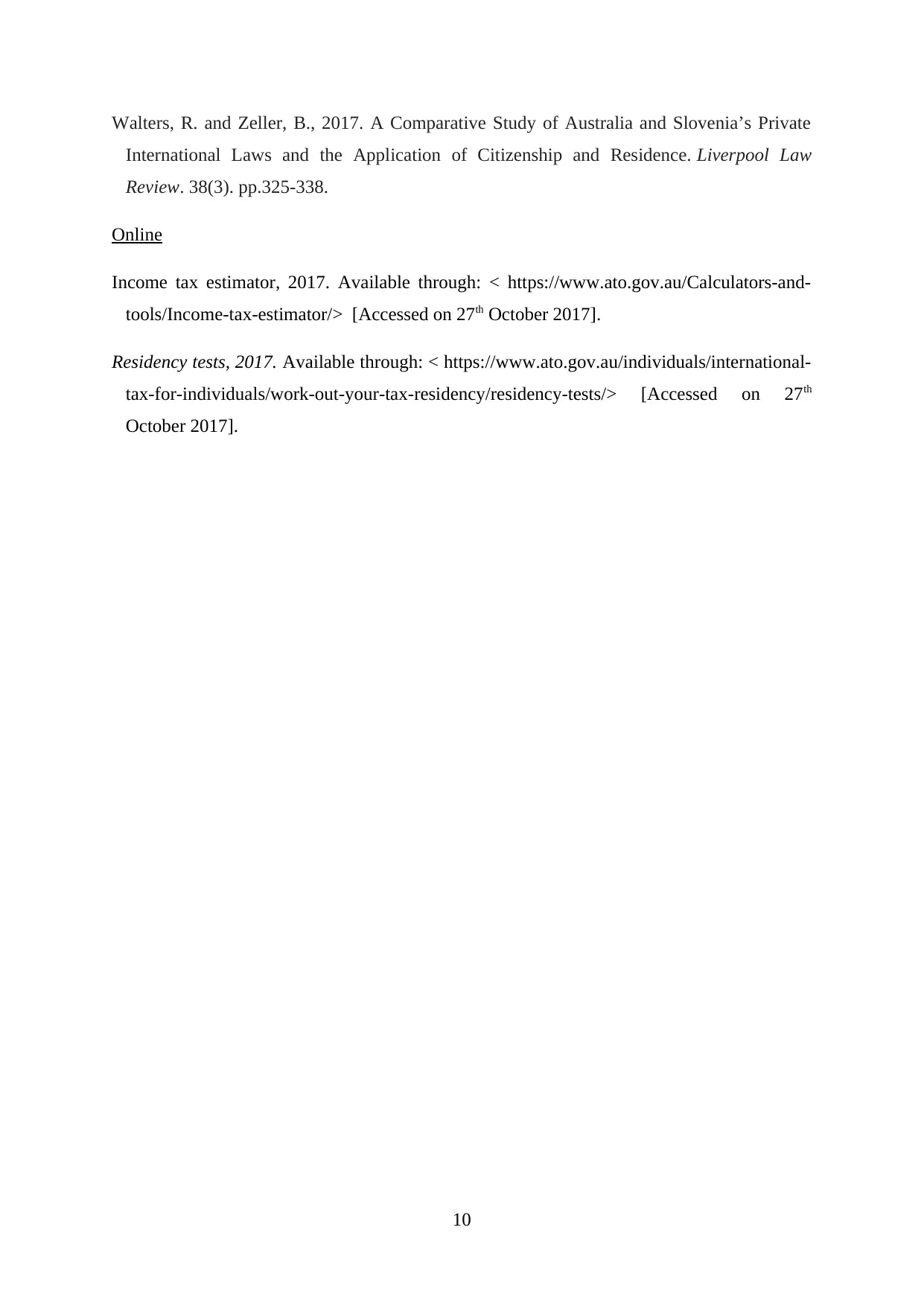
Walters, R. and Zeller, B., 2017. A Comparative Study of Australia and Slovenia’s Private
International Laws and the Application of Citizenship and Residence. Liverpool Law
Review. 38(3). pp.325-338.
Online
Income tax estimator, 2017. Available through: < https://www.ato.gov.au/Calculators-and-
tools/Income-tax-estimator/> [Accessed on 27th October 2017].
Residency tests, 2017. Available through: < https://www.ato.gov.au/individuals/international-
tax-for-individuals/work-out-your-tax-residency/residency-tests/> [Accessed on 27th
October 2017].
10
International Laws and the Application of Citizenship and Residence. Liverpool Law
Review. 38(3). pp.325-338.
Online
Income tax estimator, 2017. Available through: < https://www.ato.gov.au/Calculators-and-
tools/Income-tax-estimator/> [Accessed on 27th October 2017].
Residency tests, 2017. Available through: < https://www.ato.gov.au/individuals/international-
tax-for-individuals/work-out-your-tax-residency/residency-tests/> [Accessed on 27th
October 2017].
10
⊘ This is a preview!⊘
Do you want full access?
Subscribe today to unlock all pages.

Trusted by 1+ million students worldwide
1 out of 12
Related Documents
Your All-in-One AI-Powered Toolkit for Academic Success.
+13062052269
info@desklib.com
Available 24*7 on WhatsApp / Email
![[object Object]](/_next/static/media/star-bottom.7253800d.svg)
Unlock your academic potential
Copyright © 2020–2025 A2Z Services. All Rights Reserved. Developed and managed by ZUCOL.





